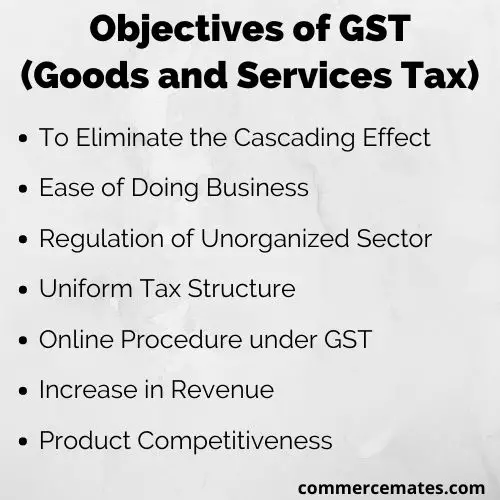Contents
Meaning of GST
GST (Goods and Service Tax) is an indirect tax which was launched by Prime Minister Modi on 1st July 2017. It is a tax which is levied by government on supply of goods and services. This tax has brought a greatest reform in Indian taxation system by replacing all indirect taxes which were levied earlier with one single tax.
GST amount are collected by sellers from buyers while purchasing a product and later on passed on to the government. It servesas a large source of revenue for both state and central government.GST is termed as one nation-one tax as it has unified the whole taxation system. There are five tax slabs for collecting tax under this- 0%, 5%, 12%, 18% and 28%.
Objectives of GST in India
- To Eliminate the Cascading Effect: Cascading effect means when is the tax on tax levied on a product at every step of the sale until it is sold to the final consumer. GST would be levied only to the net value added on the product, not to the whole value of the product.
- Uniform Tax Structure: ONE NATION ONE TAX Before the GST the tax rate is different for the different parts of the Country on different goods and services. Before GST People come to Delhi and used to buy electronics from Delhi because the tax rate on electronics in Delhi is less than in other states in India. Now, tax is the same in every state.
- Ease Of Doing Business: After GST, the problems in indirect tax have been reduced. Earlier firms faced many problems for registration of excise customs, VAT, dealing with tax authorities, etc. The benefits of GST has helped companies to carry out their business with ease.
- Regulation Of Unorganized Sector: In India, there is a lot of Sector which still Unorganized. The government tries to put those firms into the main streamline. This business can be a bakery in your locality or maybe a small factory. Now, these firms/factories/business also paying GST which increases the revenue of the Indian Government.
- Increase In Revenue: GST increases the revenues of the central government and state governments. Tax Evasion is very hard so every firm needs to pay taxes(GST). The false claim is very less due to it as this requires matching of invoices between the recipient and the suppliers.
- Online Procedure: The entire process under the GST regime starting from registration to return filling is online. Filling the GST is easier than the old Tax because we fill only one return under GST and before GST we need to fill return to every tax to tax departments.
- Product Competitiveness: GST is meeting the India Tax system with international tax standards. After GST the production cost will decrease as there is no more Cascading effect in the tax system. So, Indian product costs will be low and products can more competitive in the global market.

Nature of GST
- Multi-stage: GST is a multi-stage tax which is levied at every point of sale of goods or services. Product before reaching its final consumer passes through many stages. This tax is levied at each of the stages.
- Destination based: It is a tax that is levied on the consumption of goods and services by consumers. If a product is manufactured in Uttar Pradesh and sold in Delhi, then the GST amount will be collected by the Delhi government but not the government of Uttar Pradesh.
- Value Addition: GST is collected at value addition in each processing stage while manufacturing a final product. There are various steps from the purchase of raw materials till the product is finally ready for sale. Additional monetary value is added at every stage where GST is levied.
Scope of GST
- Easy compliance: GST makes it easy for taxpayers to compliance with required rules and regulations timely. They can avail all services relating to GST via online portal such as registration, tax payment, return filling, response to notices, etc. It has accelerated the whole process.
- Removes cascading effect: GST has eliminated the cascading effect of taxation on goods that existed in the previous tax system. Cascading effect means implying tax on tax which raises the cost of the product. Here the tax is not levied on the full value of the product but only on the net value added to it. Removal of cascading effect will make goods cheaper for consumers.
- Simplification of taxation: This tax has simplified the whole taxation procedure by eliminating around 17 indirect taxes. GST has minimized the compliance cost for business and saved them from facing various problems that arise in indirect tax previously.
- Provides transparency: The introduction of GST has provided better transparency in the collection of taxes to the government. Due to its robust IT structure, it is difficult to evade tax and make false claims by taxpayers. It has also reduced the collection cost of taxes by the government which ultimately raises its revenue.
- Bring uniformity in tax structure: GST has unified the whole tax structure of the nation. It has introduced the same tax rates for products and services across the country.
- Improve profitability: GST has reduced the transaction costs for business which facilitates them in doing operations efficiently. It has also brought down production cost by eliminating the cascading effect of tax which improves overall competitiveness for industry and trade.